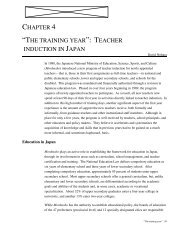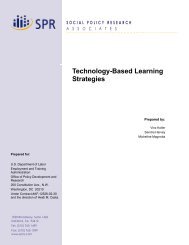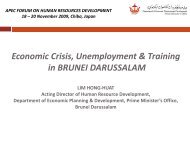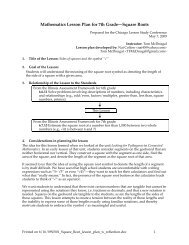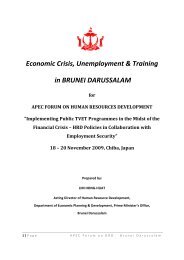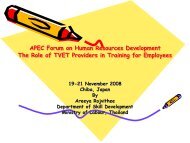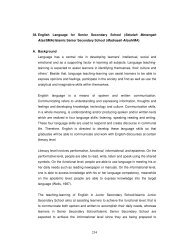Quality Assurance Systems in Asia-Pacific Economic Cooperation
Quality Assurance Systems in Asia-Pacific Economic Cooperation
Quality Assurance Systems in Asia-Pacific Economic Cooperation
You also want an ePaper? Increase the reach of your titles
YUMPU automatically turns print PDFs into web optimized ePapers that Google loves.
ENHANCEMENT OF QUALITY ASSURANCE SYSTEMS IN HIGHER EDUCATION IN APEC MEMBER ECONOMIES<br />
<br />
<br />
Fees from HEIs. In many systems, government-established or HEI-owned, <strong>in</strong>stitutions<br />
pay for the services received. This payment normally covers all expenses related to the<br />
external review, plus the cost of tra<strong>in</strong><strong>in</strong>g activities.<br />
Fee for services. Income received by the agency for services rendered to <strong>in</strong>stitutions or<br />
organisations other than those apply<strong>in</strong>g for accreditation. These other sources of <strong>in</strong>come<br />
may be conferences, workshops, consultancy, etc.<br />
Overall, most of the QA systems follow a ‘cost recovery’ or ‘fee for service’ pr<strong>in</strong>ciple and<br />
charge the HEIs for the QA exercise related to them, irrespective of their ownership.<br />
Independence<br />
The survey <strong>in</strong>dicates that <strong>in</strong>dependence means ‘Tak<strong>in</strong>g QA decisions based on the QA<br />
activity without any <strong>in</strong>terference from third party’. In both cases - government-established or<br />
HEIs-owned - there is a need to ensure <strong>in</strong>dependence from the <strong>in</strong>terests that are <strong>in</strong>herent <strong>in</strong><br />
these groups. Some systems have their <strong>in</strong>dependence written <strong>in</strong> the legislation or<br />
Constitution. What usually emerges is a system of checks and balances, and QA systems are<br />
successful <strong>in</strong> ensur<strong>in</strong>g their <strong>in</strong>dependence by balanc<strong>in</strong>g the <strong>in</strong>volvement of various<br />
stakeholders <strong>in</strong> the govern<strong>in</strong>g body. Not many have a clear policy on pay<strong>in</strong>g attention to the<br />
risk of conflict of <strong>in</strong>terest of these representatives, but there are some good practices found <strong>in</strong><br />
the APEC economies.<br />
Characteristics of the QA Framework<br />
Size of the System and Unit of <strong>Quality</strong> <strong>Assurance</strong><br />
The size of the system to be covered by the QA process varies from a few thousand HEIs<br />
(programs) to only a few. The size of the system does not seem to <strong>in</strong>fluence the choice of unit<br />
for quality assurance. But it does <strong>in</strong>fluence other aspects of QA such as policies and practices<br />
related to participation of agency staff <strong>in</strong> site visits, selection of reviewers and constitut<strong>in</strong>g the<br />
review team, and the place given to tra<strong>in</strong><strong>in</strong>g of reviewers. In large systems, there is a heavy<br />
reliance on external reviewers with limited support from the QA body. Consequently the<br />
review requires reviewers who are competent enough to adhere to the QA framework but with<br />
m<strong>in</strong>imum direct guidance from the QA staff while on the responsibility. Identify<strong>in</strong>g external<br />
reviewers may not be a big challenge <strong>in</strong> big systems but tra<strong>in</strong><strong>in</strong>g them to adhere to the quality<br />
assurance framework <strong>in</strong> a consistent manner, putt<strong>in</strong>g <strong>in</strong> place appropriate safeguards to<br />
m<strong>in</strong>imise <strong>in</strong>ter-team variances and ensur<strong>in</strong>g professionalism <strong>in</strong> such large operations may<br />
become very challeng<strong>in</strong>g. The survey <strong>in</strong>dicates that except for a couple of systems, the others<br />
have tra<strong>in</strong><strong>in</strong>g programs and attendance <strong>in</strong> workshops compulsory for reviewers which will be<br />
discussed later.<br />
Major Functions of QA <strong>Systems</strong><br />
<strong>Quality</strong> assurance systems of the APEC region have recorded different objectives and<br />
functions as their priority. For some, the predom<strong>in</strong>ant objective is accountability; for others, it<br />
is quality enhancement and provid<strong>in</strong>g public <strong>in</strong>formation on quality of the <strong>in</strong>stitutions and<br />
programs; for some others the predom<strong>in</strong>ant aim is help<strong>in</strong>g <strong>in</strong> self-improvement of <strong>in</strong>stitutions.<br />
In most cases, the objective of quality assurance is a comb<strong>in</strong>ation of all of the above, but the<br />
emphasis on each varies <strong>in</strong> different economies, depend<strong>in</strong>g on the characteristics of the<br />
higher education system and the degree of accountability required by various authorities. It is<br />
important to note that quality enhancement f<strong>in</strong>ds a mention as one of the top few objectives <strong>in</strong><br />
all the economies. Depend<strong>in</strong>g on the purpose of establishment although some have<br />
accountability as the priority agenda, quality enhancement, self improvement and provid<strong>in</strong>g<br />
<strong>in</strong>formation to public also f<strong>in</strong>d a notable mention.<br />
Mandatory vs Voluntary Nature of QA<br />
The survey <strong>in</strong>dicates a variety of approaches, and objectives to quality assurance. To a large<br />
extent, whether QA is mandatory or voluntary depends on the objectives the QA body is set to<br />
achieve. In general, when quality assurance is meant as an accountability or quality control<br />
mechanism, and thus refers to m<strong>in</strong>imum standards, it is made mandatory, at least for the set<br />
of <strong>in</strong>stitutions or programs that need quality control (that need to demonstrate accountability).<br />
xii



